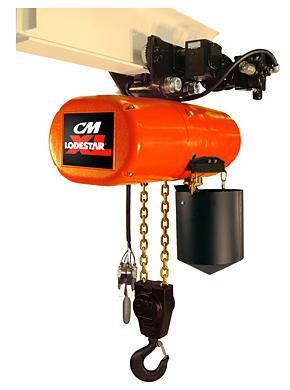Related: Electric Hoists & Electric Hoist Inspections
Electric hoists are perfect for jobs that require lifting heavy items. These heavy-duty lifting machines can lift and relocate burdensome items quickly and effectively, which in turn helps to lower worker expenses and increases your bottom line. These diverse machines can be used for both smaller scale and industrial-scale uses.
So here are the six main reasons why someone would invest in an electric hoist:
Increased Productivity: an electric hoist allows for you to hoist items quickly and effortlessly. These machines move much quicker than their manual counterparts and on top of this, they decrease the amount of muscle strain that workers may experience when moving equipment/parts around.
Higher Load Capacity: Generally speaking most electric lifting devices have a high combined hoist and trolley combination load capacity system. This causes the load capacity to range from 100-200 pounds, thus allowing for you to comfortably lift a large range of different load weights.
Cost-Effective: You probably have already come to this conclusion yourself, but electric hoists are extremely cost-effective. With their high carrying capacity and efficiency, once installed they quickly start to give you significant savings on manpower.
Versatility: These highly effective machines don’t just allow for you to lift an item vertically or horizontally, they allow for you to do both.
Less Noise: When compared to hydraulic or manual hoists an electric hoist is almost as quiet as a mouse!
Higher Durability: These hoist systems can serve you for many years, so long as they are well maintained. Regular inspections will help you to keep your machine in shape.
Unfortunately, I cannot leave it at just that, like any other machine electric hoists have their own disadvantages, including the following:
The one main issues quickly become apparent right in the name electric hoist, indicating that if there was a power outage then an item could become stuck in mid-transit something which would cause work to come to a screeching halt.
Again another issue with having an electric chain hoist is that accidents such as electric shock can occur if they are not properly inspected and maintained.
Which is why inspections are so important when you own something like an electric hoist, it ensures that they are in proper working order and ready for use when you need them. To ensure that you have an inspection schedule in place, this will help to ensure that your hoists are properly taken care of.
Though there are some things that you can do outside of regular inspections to ensure that your host has the longest lifespan possible.
Ensure that you follow these rules:
Do not lift a load that exceeds the capacity of the chain block
Do not use the blockchain as a sling
Ensure that the chain is not kinked before using it
Make sure that no one is working or passing under a lifting load
If the hand chain does not move, do NOT use force, stop operations and inspect the chain block
Only lift vertically, do NOT drag a load.
Maintenance:
This should occur after operations have been completed, you can clean the chain block of any dirt and then store it in a dry place to prevent rust and corrosion from forming.
Ensure that the “O” marks on the two disk gears are aligned and show no signs of rust or corrosion
Place the rollers of both the left and right bearings to the inner race of the bearings on the chain sprocket shaft journal, then place the outer race of the bearings on the side plates.
Once annual cleaning and repair of the chain block are complete it should be then placed under a non-load and heavy load test. If it passes it then may be placed into operation.
Pre-Use Inspection:
To ensure that the electric hoist will work well, a pre-use inspection should occur before each use.
Visually inspect the load chains for any damage
Make sure the hoist is properly secured
Ensure the load does not exceed the loading limit
Check to ensure the motions are smooth and regular and that there are no hesitations, vibrations, binding, unusual noises or any other irregularities.
Make sure the chain is not kinked or damaged.
As stated before electric hoist inspections should occur regularly and be completed by a fully trained and certified inspector to ensure that the hoist is in proper working order. Some of the things that the inspector will look at/for include some of the following:
Checking the operating mechanisms for maladjustment and listening for any unusual sounds
Checking the tightness of any bolts, nuts and/or rivets
Looking for excessive wear, corrosion, cracks or distortion in any of the following parts: load blocks, suspension housing, hand chain wheels, chain attachments, clevises, yokes, suspension bolts, shafts, gears, bearings, pins, rollers and locking/clamping devices
Looking for damage or wear on the hook-retaining nuts or collars, pins, welds and rivets that are used to secure the retaining members.
Reviewing the hand chain operated hoists and looking for evidence of worn, glazed, or oil-contaminated friction disks
Checking for any signs of damage to the supporting structure/trolley
Making sure the end connection load chains have no signs of wear, corrosion, cracks, damage or distortion
At the end of the day, an electric hoist will help to speed up production and increase your bottom line, but you have to make sure you take proper care of it and ensure that it gets regular inspections and maintenance for it to continue doing so in the future.
Do you have an electric chain hoist?
Have you ever used one before?
Is there an article you would like to see in the future?
Comment below!


